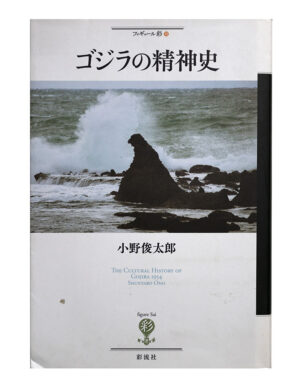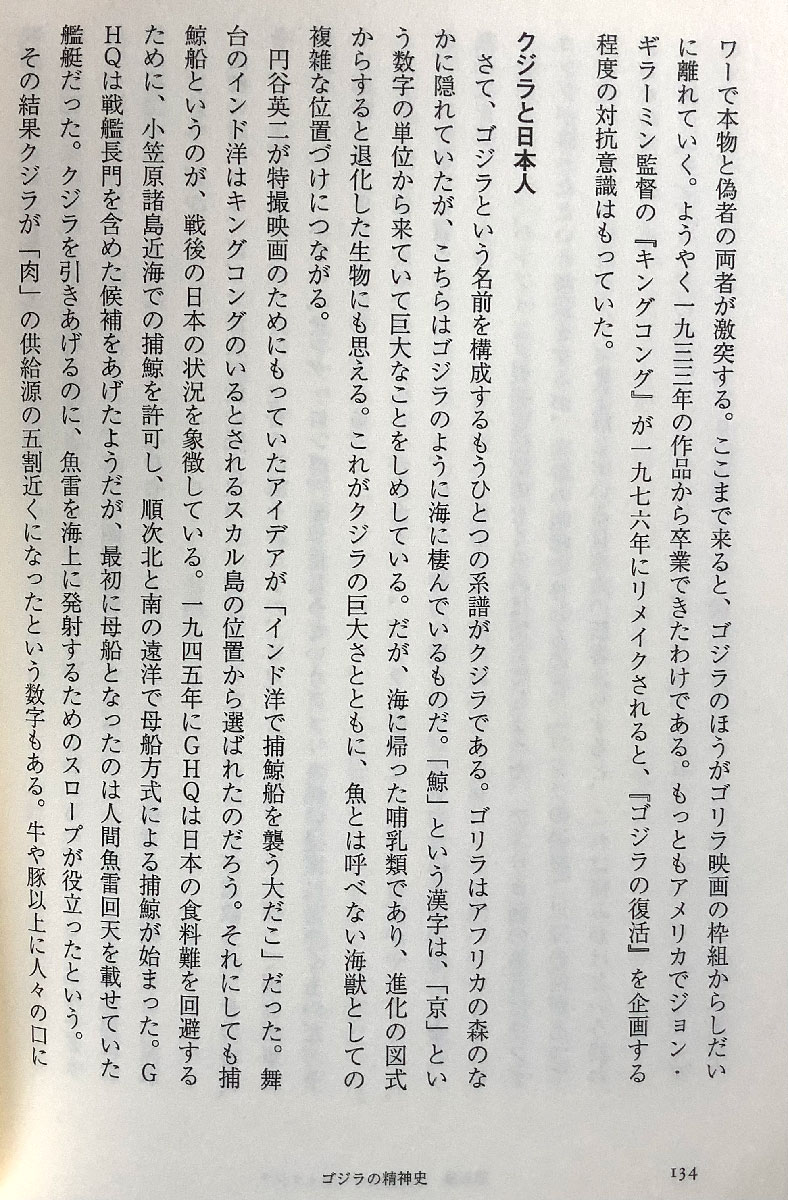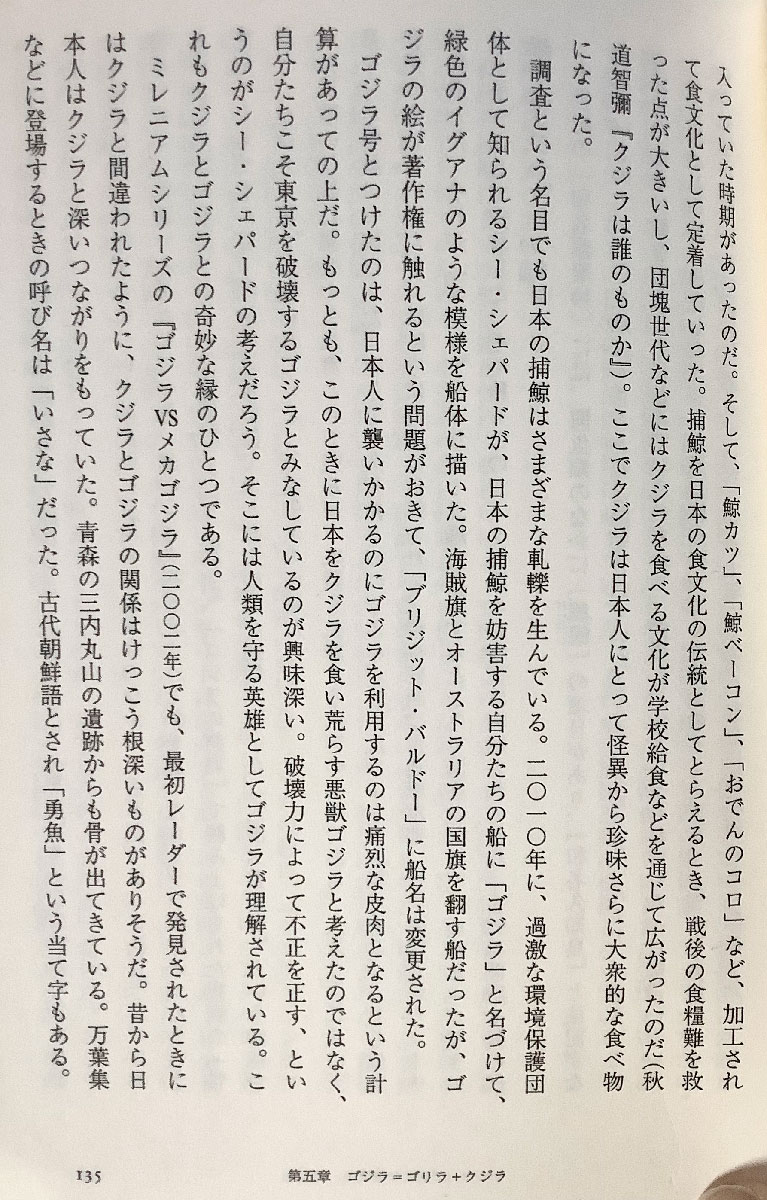6.27.2023
The Cultural History of Godzilla – Pt 51


P 134
クジラと日本人
Whale and Japanese
さて、ゴジラという名前を構成するもうひとつの系譜がクジラである。ゴリラはアフリカの森のなかに隠れていたが、こちらはゴジラのように海に棲んでいるものだ。「鯨」という漢字は、「京」という数字の単位から来ていて巨大なことをしめしている。だが、海に帰った哺乳類であり、進化の図式からすると退化した生物にも思える。これがクジラの巨大さとともに、魚とは呼べない海獣としての複雑な位置づけにつながる。
Well, another genealogy that makes up the name Godzilla is the whale. Gorillas used to hide in the forests of Africa, but this one, like Godzilla, lives in the sea. The kanji character for “whale” comes from the unit of the number “Kyo,” which means gigantic. However, it is a mammal that has returned to the sea, and it seems to be a degenerated creature from the evolutionary scheme. This, along with the whale’s enormous size, leads to its complicated position as a sea animal that cannot be called a fish.
円谷英二が特撮映画のためにもっていたアイデアが「インド洋で捕鯨船を襲う大だこ」だった。舞台のインド洋はキングコングのいるとされるスカル島の位置から選ばれたのだろう。それにしても捕鯨船というのが、戦後の日本の状況を象徴している。一九四五年にGHQは日本の食料難を回避するために、小笠原諸島近海での捕鯨を許可し、順次北と南の遠洋で母船方式による捕鯨が始まった。GHQは戦艦長門を含めた候補をあげたようだが、最初に母船となったのは人間魚雷回天を載せていた艦艇だった。クジラを引きあげるのに、魚雷を海上に発射するためのスロープが役立ったという。
The idea that Eiji Tsuburaya had for a special effects movie was “A giant octopus attacking a whaling ship in the Indian Ocean.” The setting, the Indian Ocean, was probably chosen because of the location of Skull Island, where King Kong is said to be. Even so, the whaling ship symbolizes the postwar situation in Japan. In 1945, in order to avoid Japan’s food shortage, GHQ permitted whaling in the waters near the Ogasawara Islands, and whaling by the mothership method began in the northern and southern oceans. GHQ seems to have given candidates including the battleship Nagato, but the first mother ship was a ship carrying a human torpedo Kaiten [human torpedo in WW2]. A ramp for launching torpedoes into the sea was helpful in pulling the whale up.
その結果クジラが「肉」の供給源の五割近くになったという数字もある。牛や豚以上に人々の口に入っていた時期があったのだ。
As a result, there is a figure that whales have become nearly 50% of the supply source of “meat.” There was a time when it was in people’s mouths more than cows and pigs.

P 135
そして、「鯨カツ」、「鯨ベーコン」、「おでんのコロ」など、加工されて食文化として定着していった。捕鯨を日本の食文化の伝統としてとらえるとき、戦後の食糧難を救った点が大きいし、団塊世代などにはクジラを食べる文化が学校給食などを通じて広がったのだ(秋道智彌『クジラは誰のものか』)。ここでクジラは日本人にとって怪異から珍味さらに大衆的な食べ物になった。
Then, processed foods such as ‘whale cutlet,’ ‘whale bacon,’ and ‘oden no koro’ became established as food culture. When whaling is regarded as a tradition of Japanese food culture, it largely saved the food shortage after the war, and the culture of eating whales spread among the baby boomers through school lunches (Tomoya Akimichi, “Whose whale is it?”). Here whales have gone from a monster to a delicacy to a popular food for the Japanese.
調査という名目でも日本の捕鯨はさまざまな軋轢を生んでいる。二〇一〇年に、過激な環境保護団体として知られるシー・シェパードが、日本の捕鯨を妨害する自分たちの船に「ゴジラ」と名づけて、緑色のイグアナのような模様を船体に描いた。海賊旗とオーストラリアの国旗を翻す船だったが、ゴジラの絵が著作権に触れるという問題がおきて、「ブリジット・バルドー」に船名は変更された。
Even in the name of research, whaling in Japan has caused various conflicts. In 2010, the radical environmentalist group Sea Shepherd named its ship, which was used to disrupt Japanese whaling, “Godzilla” and painted a green iguana-like pattern on its hull. She flew the pirate and Australian flags, but was renamed “Brigette Bardot” after a Godzilla painting was copyrighted.
ゴジラ号とつけたのは、日本人に襲いかかるのにゴジラを利用するのは痛烈な皮肉となるという計算があっての上だ。もっとも、このときに日本をクジラを食い荒らす悪獣ゴジラと考えたのではなく、自分たちこそ東京を破壊するゴジラとみなしているのが興味深い。破壊力によって不正を正す、というのがシー・シェパードの考えだろう。そこには人類を守る英雄としてゴジラが理解されている。これもクジラとゴジラとの奇妙な縁のひとつである。
The reason they named it Godzilla was because they calculated that using Godzilla to attack Japanese people would be a bit ironic. However, at this time, it is interesting that they did not think of Japan as the evil beast Godzilla that eats and devours whales, but that they see themselves as the Godzilla that destroys Tokyo. The idea of Sea Shepherd is to rectify injustice through destructive power. Godzilla is understood there as a hero who protects mankind. This is also one of the strange connections between whales and Godzilla.
ミレニアムシリーズの「ゴジラvsメカゴジラ』(二〇〇二年)でも、最初レーダーで発見されたときにはクジラと間違われたように、クジラとゴジラの関係はけっこう根深いものがありそうだ。昔から日本人はクジラと深いつながりをもっていた。青森の三内丸山遺跡からも骨が出てきている。万葉集などに登場するときの呼び名は「いさな」だった。古代朝鮮語とされ「勇魚」という当て字もある。
In the Millennium series “Godzilla vs Mechagodzilla” (2002), when it was first discovered by radar, it was mistaken for a whale. Since ancient times, the Japanese have had a deep connection with whales. Bones have also been found at the Sannai-Maruyama ruins in Aomori. When it appeared in the Manyoshu, it was called ‘Isana.’ It is said to be an ancient Korean word, and there is also a phonetic equivalent of “brave fish.”
Manyosho is an 8th century anthology of Japanese poetry

P 136
それに対してクジラのほうは諸説があって語源はよくわからない。「黒白」や「口広」からきたなどある。
On the other hand, there are various theories about whales, and the etymology is not well understood. It comes from “black and white” and “mouth wide.”
八世紀には、神武天皇についての記述に登場する久米歌のなかで、古事記では「久治良」が、日本書紀では「区施羅」が使われている。鳥のシギを捕まえようと網を放ったらクジラがかかったという大らかな内容の歌詞である。「区施羅」という表記が、「ゴジラの祭典」で読み上げられた祝詞の「呉「爾羅」ともつながる。明治の浮世絵師である歌川政信が捕鯨を描いた『大漁大苦児羅』という錦絵があり、やはり「羅」が使われている。万葉仮名の伝統だろう。
In the 8th century, among the Kume poems that appear in the descriptions of Emperor Jinmu, ‘Kujira’ is used in the Kojiki and ‘Ku Sera’ is used in the Nihonshoki. The lyrics are broad-minded, about how a net was thrown to catch a sandpiper, and a whale caught it. The notation “KUSHIRA” is also connected to the congratulatory address “GOJIRA” read aloud at the “Godzilla Festival.” Masanobu Utagawa, an ukiyo-e artist in the Meiji period, has a nishiki-e titled “Tairyo Daikujira,” in which he depicts whaling, and ‘Ra’ is also used. Manyo-gana tradition.
Ukiyo-e is a genre of Japanese art which flourished from the 17th through 19th centuries. Its artists produced woodblock prints and paintings of such subjects as female beauties; kabuki actors and sumo wrestlers; scenes from history and folk tales; travel scenes and landscapes; flora and fauna; and erotica. (Source: Wikipedia)
Manyo-gana is a kind of kana (the Japanese syllabaries), and it mainly refers to the letters from which Japanese people borrowed Chinese-derived pronunciation in order to express Japanese in ancient times. These letters are represented by the writing in “Manyoshu,” and therefore they are called in this way. (Source: Japanesewiki.com)
久米歌の伝統は雅楽の久米舞として残るが、戦闘を鼓舞する内容のものである。久米(来目)氏は天皇を守る警護の一族だった。そして、久米舞と対になるのが安倍氏による吉志舞である。こちらは現在残っていないのだが、戦時中に海軍に依頼されて、伊福部昭は古典風軍楽「吉志舞」というマーチを作曲した。それが『ゴジラ』でフリゲート艦が攻撃するところで演奏される。いわゆる「ゴジラのマーチ」として定着した。その後もこのマーチは数々の映画に利用されてきた。古代の歌謡や舞の伝統が『ゴジラ』とつながっている。
The tradition of Kumeuta [variety of ancient ballad] remains as Kumemai of gagaku, but the content is to inspire battle. The Kume (Kurume) clan was a family of guards protecting the emperor. Paired with Kumemai is Abe’s Yoshishimai. Although this piece does not exist today, Akira Ifukube composed a march called “Kishi-mai,” a classical military music, at the request of the navy during the war. It is played in “Godzilla” where the frigate attacks. It became established as the so-called “Godzilla’s March.” Since then, the march has been used in many movies. Ancient song and dance traditions are connected to Godzilla.
(Source: Japanesewiki.com)Gagaku is one of the traditional forms of music in Japan, China, the Korean Peninsula and Vietnam.
During World War II, Ifukube was asked to compose nationalistic themes for the islands liberated by Japan. One such theme, Kishi Mai, played when Japan officially surrendered to the United States in 1945. (Source: Wikizilla: Akira Ifukube
十世紀の「和名類聚抄」には、龍魚類のなかに「鯨」の項目があり、「和名久知良」と注記がなされているので、クジラがはっきりと鯨と認知されていたことがうかがえる。ただし、「龍魚」という項目のなかに龍などとともに並んでいるのだから、怪異としてとらえられていたのは間違いない。
In the 10th-century “Wamyo Ruisho,” there is an entry for “whale” among dragon fish, and a note is given as “Kuchira Wana,” it can be seen that whales were clearly recognized as whales. However, since it is lined up with dragons in the item “dragon fish,” there is no doubt that it was regarded as a monster.
The Wamyō ruijushō or Wamyo ruijusho is a 938 CE Japanese dictionary of Chinese characters. The Heian period scholar Minamoto no Shitagō began compilation in 934, at the request of Emperor Daigo’s daughter. (Source: Wikipedia)
東京湾の品川沖に出没したゴジラが品川駅を襲ってくる場面のイメージも、クジラと無縁ではない。現在鯨塚が品川の利田神社にある。これは寛永十年(一七九八)五月に暴風雨のあと体長十六メートルかがたを越すクジラがやってきたのを、天王洲の漁師たちが仕留めたものを供養している。
The image of the scene where Godzilla, which has appeared off the coast of Shinagawa in Tokyo Bay, attacks Shinagawa Station is not unrelated to whales. Currently, there is a whale mound at Toda Shrine in Shinagawa. This is a memorial service for the fishermen of Tennozu who killed a whale over 16 meters in length after a storm in May of the 10th year of Kanei (1798).

P 137
最終的に腐敗してきたので油をとったというが、いわゆる鯨油である。食肉ではなくて油の確保が、アメリカなどの捕鯨の目的だった。ただし、十九世紀半ばにカナダ人のゲスナーが石油からケロシン(灯油)を取り出発明をしたことで、日常の鯨油の利用は減っていった。これが反捕鯨運動の根拠となっている。
It is said that the oil was removed because it eventually rotted, but it is so-called whale oil. Securing oil, not meat, was the purpose of whaling in the United States and elsewhere. However, in the mid-19th century, Canadian [Abraham Pineo] Gesner invented kerosene (kerosene) from petroleum, and the daily use of whale oil declined. This is the basis of the anti-whaling movement.
大戸島とアメリカの影
Odo Island and America’s shadow
戦後の捕鯨はまず小笠原諸島付近でGHQによって解禁されたが、十二海里内に日本人が立ち入ることが禁じられていたので、小笠原の島に捕鯨基地を作ることは許されなかった。そこで、小型のキヤッチャーボートとクジラを解体処理して貯蔵する母船からなる方式が採用された。戦前はクジラかとる鯨油や肉の缶詰(大和煮)が外貨を獲得するために利用されたが、戦後は食糧難をおぎなう重要なタンパク源となった。
After the war, the GHQ lifted the ban on whaling around the Ogasawara Islands, but Japanese people were prohibited from entering within 12 nautical miles, so they were not allowed to build a whaling base on the Ogasawara islands. Therefore, a system consisting of a small catcher boat and a mother ship that dismantles and stores whales was adopted. Before the war, whale oil from whales and canned meat (Yamato-ni [beef boiled with soy sauce, ginger and sugar]) were used to earn foreign currency, but after the war they became an important source of protein to make up for food shortages.
じつは小笠原諸島が鍵となる。『ゴジラ』という映画におけるアメリカの影は、『キング・コング』のような先行する作品との関係だけではない。尾形が恵美子をデートに誘うときの「ブダペスト弦(絃)楽四重奏団」もそうなのだ。名前は結成したハンガリーに由来するが、この当時メンバーは全員ロシア人となり、一九四〇年以降アメリカを根拠地にしていた。名前とは裏腹にアメリカからの文化使節でもあったのだ。
In fact, the Ogasawara Islands are the key. America’s shadow in the movie “Godzilla” is not only related to preceding works such as “King Kong.” The same goes for the Budapest String Quartet when Ogata asks Emiko out on a date. Although the name derives from Hungary where it was formed, the members were all Russian at this time, and since 1940 they have been based in the United States. Contrary to his name, he was also a cultural envoy from America.
それ以上に『ゴジラ』に潜むアメリカを教えてくれるのが、おなじみの「大戸島」なのだ。ゴジラが出現した場所が日米の激戦地となった硫黄島の近くというのは、第一章で指摘したとおりだ。
More than that, it is the familiar “Odo Island” that teaches us the America hidden in “Godzilla.” As I pointed out in Chapter 1, the location where Godzilla appeared was near Iwo Jima, the site of a fierce battle between Japan and the United States.